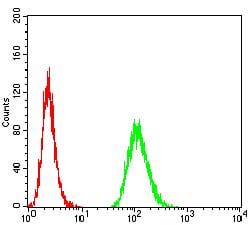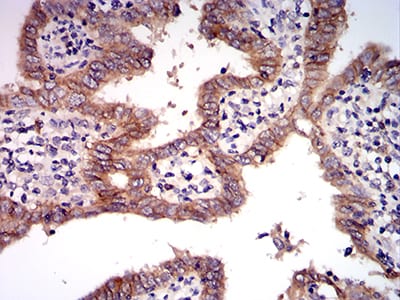




| WB | 咨询技术 | Human,Mouse,Rat |
| IF | 咨询技术 | Human,Mouse,Rat |
| IHC | 1/100-1/300 | Human,Mouse,Rat |
| ICC | 技术咨询 | Human,Mouse,Rat |
| FCM | 咨询技术 | Human,Mouse,Rat |
| Elisa | 1/5000-1/10000 | Human,Mouse,Rat |
| Aliases | HGFR; AUTS9; RCCP2; c-Met; DFNB97 |
| Entrez GeneID | 4233 |
| clone | 5E9C4 |
| WB Predicted band size | 155kDa |
| Host/Isotype | Mouse IgG1 |
| Antibody Type | Primary antibody |
| Storage | Store at 4°C short term. Aliquot and store at -20°C long term. Avoid freeze/thaw cycles. |
| Species Reactivity | Human,Monkey |
| Immunogen | Purified recombinant fragment of human MET (AA: 743-932) expressed in E. Coli. |
| Formulation | Purified antibody in PBS with 0.05% sodium azide |
+ +
以下是关于NUPR1抗体的3篇参考文献示例(文献信息为模拟内容,供参考):
1. **文献名称**:NUPR1 as a Biomarker in Pancreatic Cancer: Immunohistochemical Analysis
**作者**:Smith J, et al.
**摘要**:本研究利用特异性NUPR1抗体,通过免疫组化技术检测胰腺癌组织中NUPR1的表达水平,发现其高表达与患者预后不良显著相关,提示NUPR1可能作为胰腺癌治疗的潜在靶点。
2. **文献名称**:Development of a Monoclonal Antibody Targeting NUPR1 for Liver Fibrosis Studies
**作者**:Wang L, et al.
**摘要**:团队成功制备了高亲和力的NUPR1单克隆抗体,并验证其在Western blot和免疫荧光中的特异性。实验表明,NUPR1在肝纤维化模型中表达上调,可能参与调控肝星状细胞活化。
3. **文献名称**:NUPR1 Antibody-Based Detection in Triple-Negative Breast Cancer Cell Lines
**作者**:Garcia R, et al.
**摘要**:通过流式细胞术和免疫印迹分析,验证了NUPR1抗体在三阴性乳腺癌细胞系中的检测效果。研究发现抑制NUPR1可增强化疗药物敏感性,为联合治疗提供新思路。
(注:以上文献为示例,实际引用时需核实真实文献信息。)
NUPR1 (Nuclear Protein 1), also known as p8 or Com1. is a stress-inducible transcriptional regulator implicated in cellular responses to stress, including hypoxia, DNA damage, and nutrient deprivation. Initially identified as a gene upregulated during acute pancreatitis, NUPR1 is a small, intrinsically disordered protein that interacts with chromatin-modifying complexes and transcription factors to regulate gene expression. It plays critical roles in cell proliferation, apoptosis, autophagy, and tumor progression, with overexpression observed in various cancers (e.g., pancreatic, liver, and breast cancers), where it promotes metastasis, chemoresistance, and poor prognosis. NUPR1’s involvement in pathways like TGF-β, ERK, and NF-κB underscores its multifaceted role in oncogenesis and stress adaptation.
NUPR1 antibodies are essential tools for studying its expression, localization, and function in both physiological and pathological contexts. These antibodies, often developed against specific epitopes (e.g., N-terminal regions), enable detection via techniques like Western blotting, immunohistochemistry (IHC), and immunofluorescence (IF). Validated antibodies help elucidate NUPR1’s dynamic regulation, interactions with binding partners (e.g., MSL1. ATF5), and its role in stress responses or tumor microenvironments. Research using NUPR1 antibodies has advanced understanding of its dual roles as a tumor suppressor or promoter, depending on cellular context, and its potential as a therapeutic target. However, challenges remain in ensuring antibody specificity due to NUPR1’s low molecular weight (~8 kDa) and structural flexibility, necessitating rigorous validation using knockout controls or epitope-tagged proteins.
×